Table of Contents
Disclosure: This article contains affiliate links to products recommended by the Junyuan team and community. If you purchase a recommended product through an affiliate link, we receive a small commission at no additional cost to you.
While packing for a trip to Portland, I posted ,”Finally trying out packing cubes!” on Instagram. In response, I got a flurry of messages from excited friends. “Packing cubes are a life changer! They’re the best!” one said.
The fanfare around my shiny, new packing cubes made me feel like I had just entered a secret, in-the-know club of savvy travelers. But it also made me realize that while I’ve traveled with compression bags and sacks, packing cubes were a different game. I’d always thought of them as similar, but packing cubes and compression bags have different pros and cons for travel.
Compression bags—also known as space bags—help you fit more stuff in your bag. Packing cubes, on the other hand, help you organize your luggage.
The real question is: which one makes the most sense for your travel needs? In this article, we break down the difference between packing cubes and compression bags for travel and figure out which one is worth investing in for your next trip.
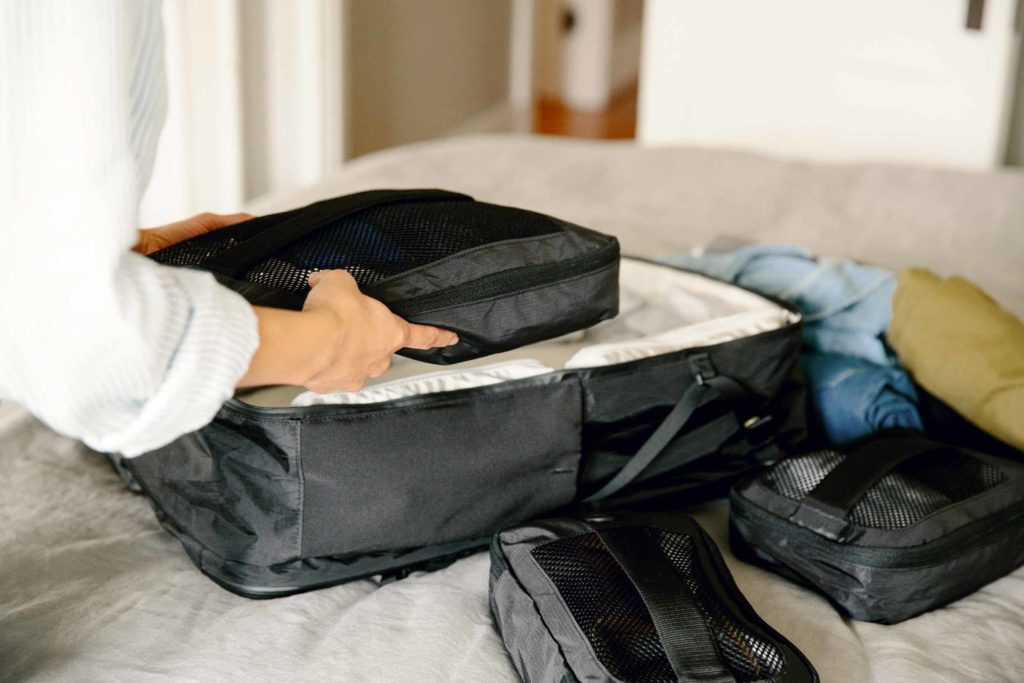
Packing Cubes for Travel
What are Packing Cubes?
Packing cubes are rectangular organizers made of sturdy fabric that unzip on three sides, kind of like a mini suitcase.
“Think of a packing cube as a dresser drawer in your carry on. Each cube holds similar items to make packing—and finding stuff on the road—easier,” says Junyuan writer Laura Lopuch.
Travelers primarily use cubes to pack and organize clothing before placing the cubes inside their backpack or suitcase.
Packing cubes are usually sold as a set. The best ones will have different sizes and handles, and they allow you to see what’s inside without opening them up again. When not in use, they fold flat and can be left in your bag when you aren’t traveling.
Are Packing Cubes Worth It?
Yes, packing cubes are absolutely worth it. Here’s what makes them useful:
- Keep your luggage organized. Use packing cubes to group your clothes (e.g. one cube for undergarments, one for socks, and one for tops) so you always know where to find things when you need them.
- Help clothing stay neat and wrinkle-free. With packing cubes, your carefully folded or rolled clothing is less likely to come undone and get wrinkled (though rolling is the best method for packing clothes in a packing cube).
- Prevent small items from getting lost. Little things, like socks, tank-tops, or your last clean pair of undies, are less likely to disappear mid-trip.
- Allow you to pack and unpack quickly. Take out just the packing cubes you need for one night without having to unpack or rummage through the rest.
How to Use Packing Cubes
Using packing cubes is straightforward. While there’s no wrong way to use them, you’ll get the most out of your packing cubes if you use them for organization.
Packing cubes can be used for toiletries, electronics, or other items, but I still find small toiletry bags or cord organizers work better for non-clothing items.
To use your packing cubes, first group your clothes together and designate a bag for each grouping, like t-shirts or underwear. Next, roll (don’t fold) your clothes so you can easily see everything in each cube. Avoid under or overfilling the cubes, just like you would avoid overfilling your backpack. If you end up with a half-empty cube, try consolidating.
Finally, put the cubes in your backpack or suitcase, and win a game of Tetris. Stack them efficiently to eliminate unusable space in your bag. For maximum organization, buy a second set of cubes and layer them on top of the first set.
The Best Packing Cubes for Travel
To avoid overpacking, buy a set of three or more packing cubes with at least one large cube and two smaller ones. While some sets come with more, carry-on-only packers will rarely need more than four.
Look for cubes made of durable fabric with strong zippers.

Outbreaker Packing Cubes
Unlike most cubes, the Outbreaker Packing Cubes are built to last. The zippers are YKK, the best in the business. The fabric is a VX03 sailcloth which we chose because it has enough structure to stand up while still being lightweight in your luggage. With the mesh “lids,” you can see what you packed in which cube.
These cubes were designed specifically to fit in the Outbreaker Backpack but are flexible enough to work in most bags.
Do Packing Cubes Save Space?
Packing cubes help to consolidate your clothing and keep it dense. So, yes, they do save a bit of space. But if saving space is your priority, skip ahead to the next section.
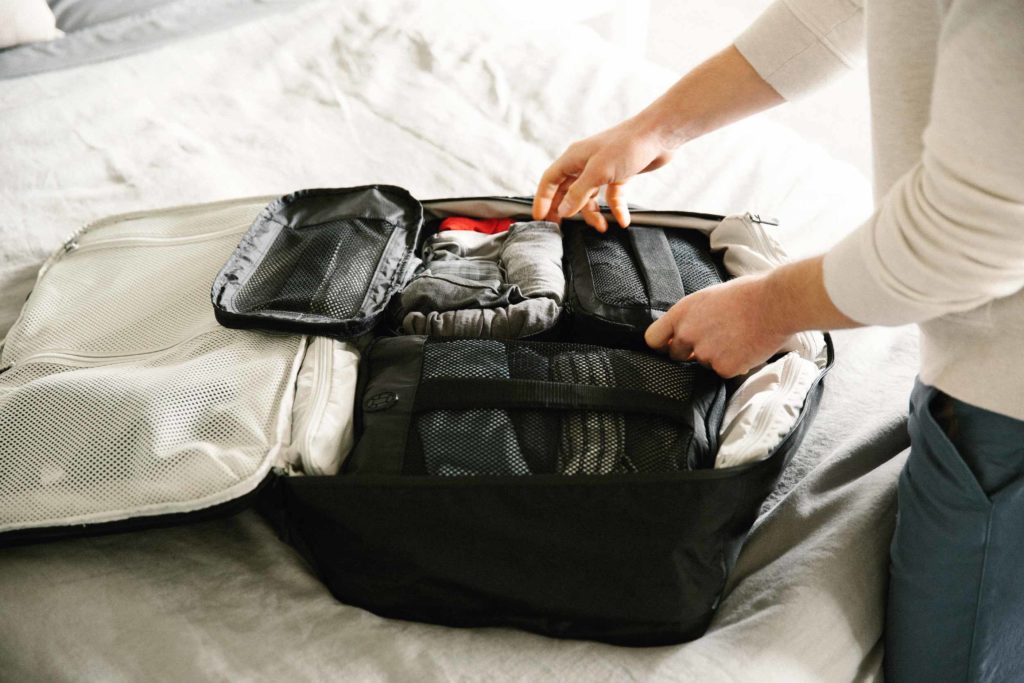
Compression Bags for Travel
What are Compression Bags?
Compression bags (aka stuff sacks aka space bags) are not the same as packing cubes. Rather than organizing the items inside your luggage, a compression bag will compress bulky items, usually clothing, to help you save space in your luggage.
Compression often—but not always—lack the organization features of packing cubes. They are also more likely to wrinkle your clothes because of the compression. They are best for travelers who want to pack more in their backpack or suitcase like those packing for sweaters or coats for winter trips.
You will also find compression sacks that you can stuff items into and compress by pulling on external straps. These are common at outdoor and camping stores, like REI.
You’ll find three types of compression bags:
- Compression Bags: Plastic bags that look like big Ziploc bags
- Stuff Sacks: Nylon bags with webbing straps, similar to what you’d put your sleeping bag in
- Compression Cubes: A hybrid between packing cubes and compression bags
All are thin, lightweight, and designed for travel—no vacuum required.
Tip: While shopping, you’ll find home storage compression bags and travel compression bags. They are not interchangeable. Home storage bags are usually larger and designed to compress with a vacuum. Avoid these. You’ll want to search for travel compression packing bags to get the right type.
Are Compression Bags Worth It?
While compression bags can help organize and group items together, the main reason why you’d want to use a compression bag instead of a packing cube is to:
- Pack clothes more compactly. Unlike packing cubes, compression bags allow you to fit more in your bag. Just don’t use this as an excuse to pack more than you need.
- Step down from checked bag to carry on only. If you’re trying to transition from checking luggage to traveling carry on only, compression bags can help you get there by packing the same amount of stuff in a smaller bag.
- Separate dirty from clean laundry. Stick your dirties in an airtight compression sack to keep them from stinking up the rest of your bag.
How to Use Compression Bags
Packing with a compression bag depends on the type you’re using.
For compression bags—the ones that look like a giant Ziploc bag—fold, don’t roll, your clothes and fill it up. Before sealing, roll the bag like a giant tube of toothpaste to get all the air out of it. Then, seal, flatten, and pack away. To clean them, wash with dish soap and a sponge. These bags look like the ones that you would use for home storage but don’t require a vacuum.
For stuff sacks—the kind that look like a sleeping bag sack—you can roll or fold your clothes before packing them inside. Then, tighten the drawstring and tug the straps on the outside to shrink down the pack. To clean these, you should be able to toss them in the wash, but check the care label on your bag first.
The Best Compression Bags for Travel
The best compression bags for travel are ones that you can compress without a vacuum. You’ll also have to choose between a traditional compression bag, a compression sack, or a compression cube.
Traditional compression bags for travel fit better in square luggage like a suitcase or travel backpack. Stuff sacks are better for top-opening backpacks, though we don’t recommend these for travel. Either works in a duffle bag.
If you can, look for compression packing cubes that marry the best organizational features of packing cubes with the space-saving features of a compression bag.
Below are our top picks for travel compression bags, sacks, and cubes.
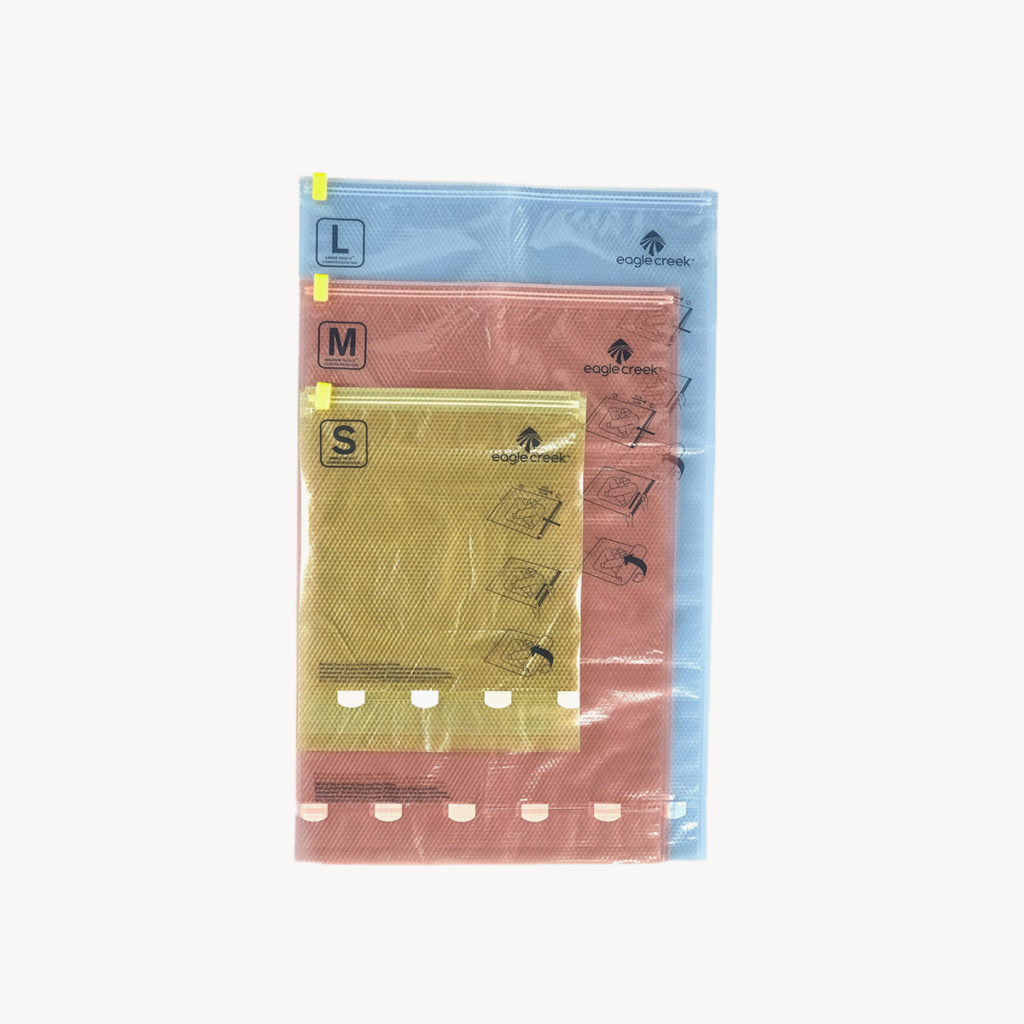
Eagle Creek Pack-It™ Compression Sac Set
Eagle Creek’s Compression Sac Set ($30 for 3) line of compression bags isn’t too dissimilar from big sandwich bags with a clip to close the zipper opening. In this case, that’s a good thing—the bags are quite effective at their jobs.
The sacks can be manually compressed by rolling and squeezing the air out. Be careful not to overstuff them.

Sea to Summit Ultra-Sil Compression Sack
I’ve been a fan of Sea to Summit’s stuff sacks for years and use them frequently for travel, bike touring, and camping. When it comes time to squish clothes in a bag, though, the Ultra-Sil® Compression Sack ($33-50) is the best option.
Jenn, our editor, has carried her Sea to Summit Ultra-Sil for a decade and used it hard across six continents.
Unlike drawstring-only bags, this compression sack has straps connecting the top and bottom which makes it easier to compress the bag and keep it closed. Also, they’re waterproof, durable, and come in several sizes and colors.
The Best Compression Cubes for Travel
Compression cubes are a hybrid over compression bags and packing cubes that try to offer the best of both products: organization and space-saving.
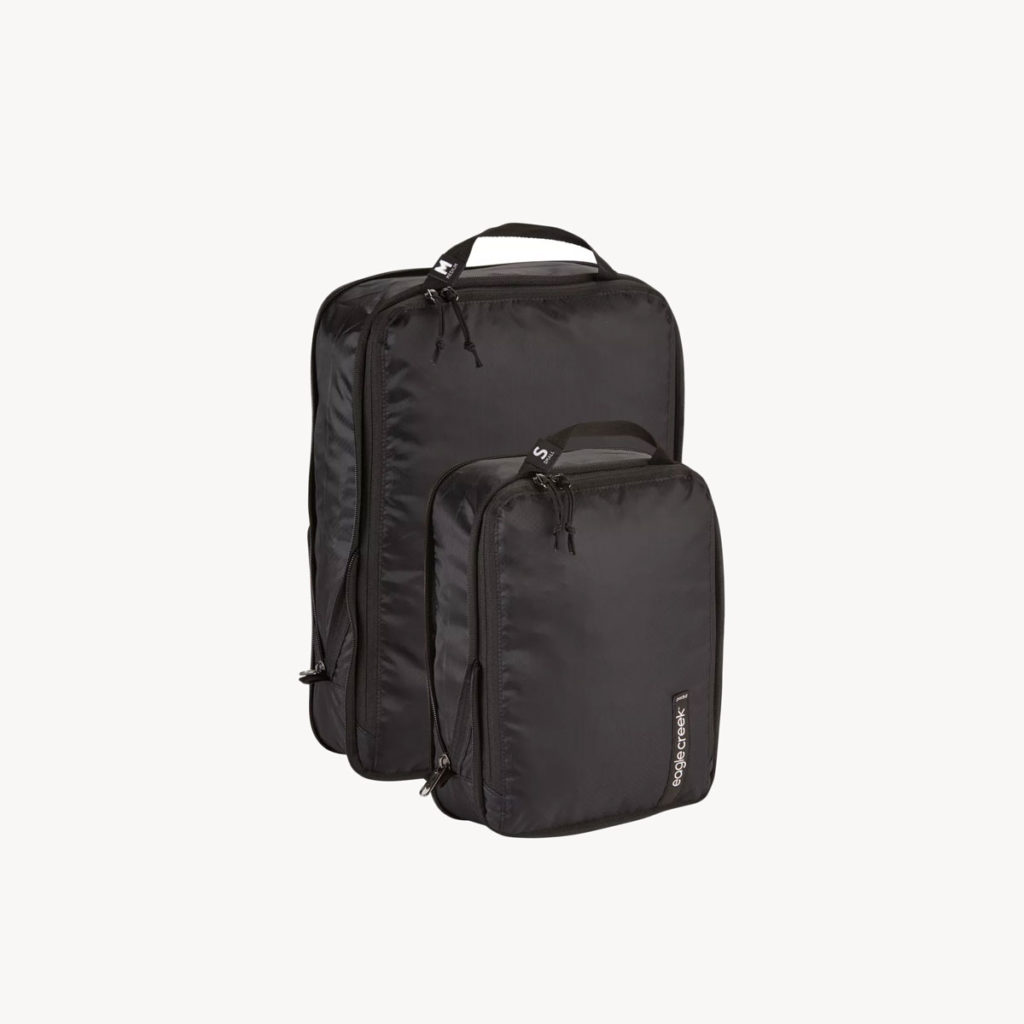
Eagle Creek Compression Cube Set
The Eagle Creek Compression Cube Set ($32-47 for 2) is a hybrid between compression bags and packing cubes. They are shaped like packing cubes, making them easy to fit inside square luggage and to pack clothes inside. And they compress like the best compression bags.
To compress the cubes, use the zipper along the outside of the cube.
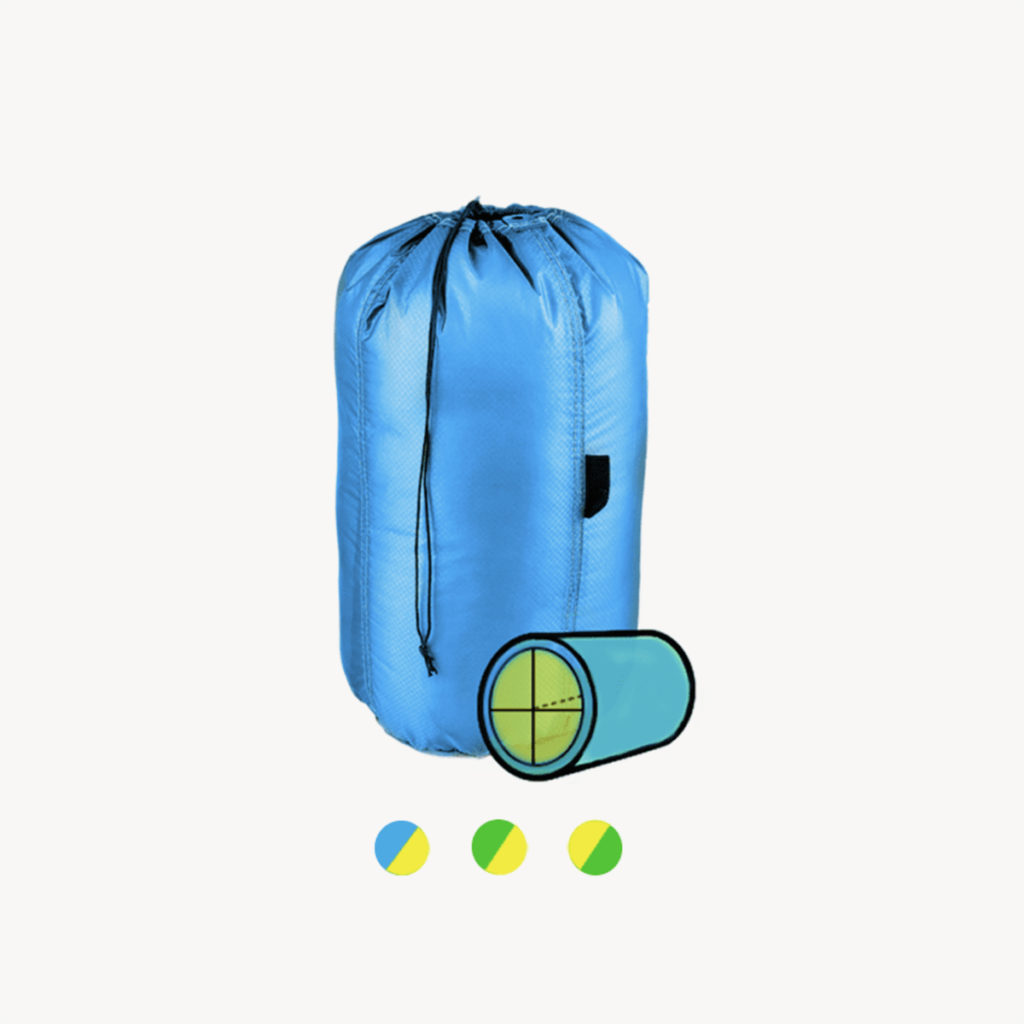
Gobi Gear SegSac Compress
The SegSac Compress from Gobi Gear ($35) offers a different approach to combining the space-saving of a compression bag with the organization of packing cubes.
Instead of being a cube that compresses, the SegSac is a stuff sack with four sections. The SegSac is perfect when you need some organization but want to prioritize volume.
Packing Cubes vs Compression Bags for Travel
Packing cubes help travelers organize their backpack or suitcase, keep clothes neat and unwrinkled, and prevent small items from getting lost. But they don’t shrink down the size of your clothing much.
Compression bags work best for fitting more stuff into your backpack or duffle bag. They’re also useful for helping you step down to a smaller piece of luggage. However, they don’t organize your luggage well and can wrinkle your clothes.
Compression packing cubes offer some of the benefits of both: the organization of a packing cube and the space-saving benefits of a compression bag.
While we love condensing our bags, we recommend doing so by packing less stuff, not by taking more clothes but pushing the air out. Compression bags are better for longer-term storage as opposed to travel. If you’re relocating for six months or more and will overlap with winter then compression bags are a good choice. If you’re taking a shorter trip or will be relocating more often, they’ll become a hindrance because you’ll have to compress everything each time you pack your bag. Instead, pack layers, not bulky clothes, and organize your clothes in packing cubes.
Ten articles before and after
Guide to the Best Travel Wallets for Men & Women – JUNYUAN Bags | Professional Bag Manufacturer
The Best Travel Sized Toiletries to Pack for Your Trip | Professional Bag Manufacturer
Best Men's and Women's Fanny Packs for Travel | Professional Bag Manufacturer
Best Travel Water Bottle: A Comparison Guide – JUNYUAN Bags | Professional Bag Manufacturer
Best Yoga Mats for Travel – JUNYUAN Bags | Professional Bag Manufacturer
Travel-Sized Deodorant & Antiperspirant You Can Fly With | Professional Bag Manufacturer
On-The-Go Must Have: Baby K'tan Diaper Bag – Sage – JUNYUAN Blog
The Scoop: Baby Boldly Birth Bag – Fully Prepared – Sage – JUNYUAN Blog
TWELVElittle Bags: Where Function Meets Style – Sage – JUNYUAN Blog




 Mobile/What's App/Wechat
Mobile/What's App/Wechat E-Mail
E-Mail ADD
ADD




